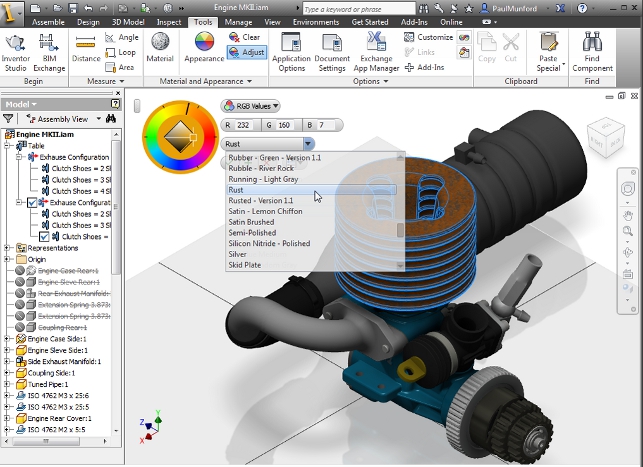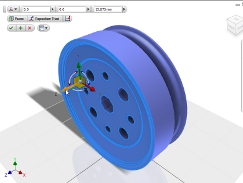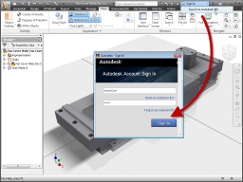What would you prefer from the latest release of your favourite software? Exciting new features that will change the way you work or bug fixes and incremental improvements to all those nagging issues from the last release?

Parts colours and textures can be adjusted using an ‘in canvas’ mini toolbar to make the manipulation of colour and scale texture mapping an intuitive experience
With Autodesk Inventor 2013, have Autodesk managed to do both?
Incremental improvements to workflow do not sell products. Try telling your boss why a centre point rectangle sketching tool is a ‘must have’ new feature and… Well, you get my point.
The really big selling points are often the tools that take us the longest to learn and implement. The best improvements for us users are the tools that slip right into our current workflow, saving us picks and clicks, without disrupting what we already know.
I can therefore say that I am genuinely impressed by the sheer quantity and breadth of the changes that come with Autodesk Inventor 2013.
There are a few interesting new tools that might help you sell Inventor 2013 to your boss, with a great number of improved features to make your everyday work that much easier.
Materials and appearances
Continuing the move to a single materials library across the range of Autodesk products, Inventor 2013 has a completely new materials and appearances structure.
The main library is now split into three components:
• Autodesk Inventor Material Library – The familiar Inventor materials
• Autodesk Material Library – Materials (physical properties) that can be shared across all Autodesk products
• Autodesk Appearance Library – Appearances (colours and textures) that can be shared across all Autodesk products Materials and Appearances are now two distinct tools, with their own Ribbon tab and handy drop downs menus in the Quick Access Toolbar (QAT).
Any custom materials and colours from previous versions of Inventor will need to be migrated into the 2013 materials and appearances library before they can be used.
On the plus side, the user now hasaccess to a whole swathe of materials that they didn’t have before.
This means that users are more likely to find what they need without having to resort to further customisation.
This is a very handy addition for users who wish to share material property data between digital prototyping and BIM software (BIM = ‘Building Information Modelling’ – think digital prototyping for buildings).
The (ubiquitous) cloud
Autodesk Inventor was designed to make use of Local Area Network (LAN) technology, which means that it creates a lot of referenced files. Working away from the office with Inventor is frankly a bit of a pig.
Autodesk have included two new workflows in Inventor 2013 to help users make use of the cloud to alleviate this problem. By being Citrix compatible, the user can log into their company’s server via Citrix and manipulate files remotely.
With good bandwidth, this could be a great option for users who wish to protect their intellectual property (IP) as the data never leaves the office.
Inventor 2013 includes a new toolset for saving files to Autodesk 360 (Autodesk cloud). The new tools can be found under the ‘Online’ ribbon tab. Clicking on ‘save and send to cloud’ will essentially use the existing ‘Pack & Go’ functionality of Inventor to grab all the user’s files and save them to their Autodesk Cloud documents account.
From here the user can download the document set to another machine to continue working, or invite others to share their files. Unfortunately there is none of the automatic file syncing that has been included with AutoCAD 2013, but this tool could prove to be extremely useful none the less.
Apps
Autodesk has been working hard behind the scenes to make it easier for third party programmers to create plug-in applications for Autodesk Inventor. To promote this, Autodesk has created an online ‘App store’ for Inventor.
With the Inventor App store, users can download Apps quickly and easily. Once downloaded, Apps can be managed from the ‘Exchange App Manager’ tab.
Deployment
Access to the new ‘Online’ tools can be controlled as part of the deployment options. Autodesk has continued with the move to hosting the Help fi les in the cloud; however you can download and install a local help file. This can be rolled out via the deployment wizard.
Useful tweaks to old favourites
First of all, Inventor 2013 includes a number of improvements in the sketching environment.
There are new tools for creating centre point and three point centre rectangles as well as Equation curves.
The trim and extend commands have had some attention too and the user can now dynamically trim and extend geometry simply by waving over it with the cursor. This may require a steady hand – hold off on that coffee!
2D and 3D Splines can now be created with CV points and 3D sketch geometry can now be dragged around, even when the sketch is closed. Geometry in 2D sketches can be mirrored about itself and 3D geometry can be mirrored about a plane or feature.
The sketch environment sports a useful new addition to the UI. A series of icons in the system bar allows for easier access to the commands for slicing the graphics display and toggling the display of dimensions, constraints and degrees of freedom on and off.
There are new tools for creating primitives, which combine the creation of sketch geometry with the appropriate sketch based feature to create boxes, cylinders, spheres and doughnuts in one simple work flow.
The good old ‘End of Part Marker’ has learned a few new tricks and can be inserted under any feature in the tree with a right click. By clicking on the EOP itself, the user can send the EOP to the top or the bottom of the feature tree, which will be extremely handy when building complex Multi-body ‘Master’ parts.
Even the frame generator has received a few welcome tweaks. Curved members can now receive end treatments and frame members can be rotated to match existing geometry.
Simulation
The stress analysis environment has new tools for coping with thin walled parts.
These new features have been exposed via the application programming interface (API). Performance of mesh creation has been improved by using all the user’s machine cores to generate the mesh.
Plastic parts/tooling
Autodesk has made a number of tweaks to the tooling environment, including tools to create and locate virtual sprues, the ability to include surfaces from a derived part and the ability to locate the centre for part shrinkage by adding your own Unconfined Compressive Strength (UCS).
Interoperability
Inventor 2013 includes updated translators for CATIA V5, Granite, NX, Parasolid, Rhino, Solidworks and SAT. The translator for JT has also been updated and now supports import of mesh data.
Inventor 2013 can import SAT files, and can output STL files, which include colour information for 3D printing. Inventor 2013 can also support point clouds.
Point Clouds can be attached in asc .ptg .cl3 .pts .clr .ptx .fl s .txt .fws .xyb .las and .xyz formats in parts or assemblies and can be moved, scaled, clipped or rotated. Point clouds can be used to create Work Axis and Work Planes, which the user can then use to create model geometry or attach parts in an assembly.
For those users who have Inventor as part of the Factory Suite, they can snap assets directly to their point cloud.
Solid editing
If a user has the need to edit files imported in a neutral format and they don’t want to use Inventor fusion, then they may be pleased to hear that there are improvements here aswell.
When it comes to solid editing, the user can move faces and features around simply by selecting and pulling them
By turning on the ‘Legacy’ solid editing environment in the application options, they can right click on a solid body to edit it.
The solid editing environment is like a mini direct modeller built right into Inventor 2013.
The user can move faces and features around simply by selecting and pulling them.
Additionally, the entire surface of a part can now be offset. These moves are not parametric and no features are added to the tree.
This will be a very handy tool for those building dies for plastic or metal parts from third party models.
Good news for subscribers
There is more good news for those users who jumped on the Subscriber train early.
Autodesk ‘Standard’ Product Design Suite subscribers will now receive Inventor in their suite (they only had AutoCAD before). ‘Premium’ subscribers receive a free upgrade to include Inventor routed systems and Navisworks simulate.
Conclusion
This article only covers the highlights of the new features in Inventor 2013.
There are many more tweaks and additions that I haven’t had space to discuss here, which I am sure that you will enjoy finding for yourselves.
Autodesk is plainly working toward its goal of interoperability between Autodesk products and the delivery of services via the cloud.
However, I am impressed by how many ‘little’ improvements have been made to this release that will improve the workfl ow for the everyday user.
Has Autodesk managed to bring new features to Inventor 2013 that will compel your company to buy it whilst also making improvements that will satisfy those of you who are on subscription? I think so.
Inventor 2013 looks like a great release, not one to leave on the shelf.
Biography:Paul Munford
Paul Munford uses digital prototyping techniques to create manufacturing drawings for all thebits that finish off the inside of buildings.

In his spare time he writes the CadSetterOut.com blog and wonders if he should get out more.
| Product | Inventor 2013 |
|---|---|
| Company name | Autodesk |
| Price | on application |











